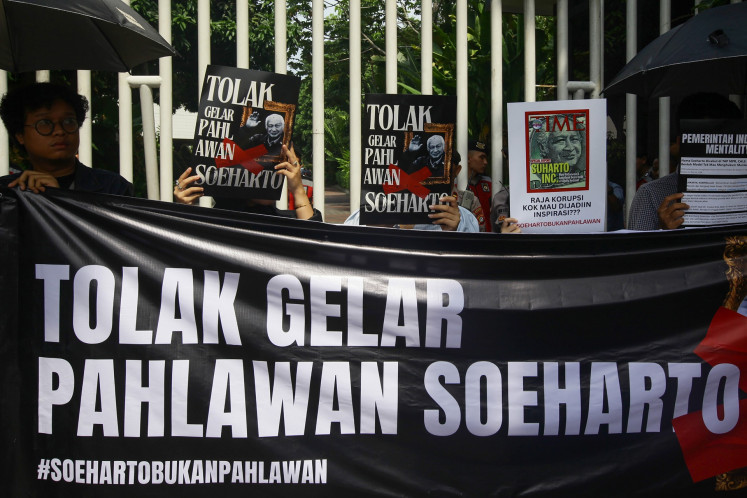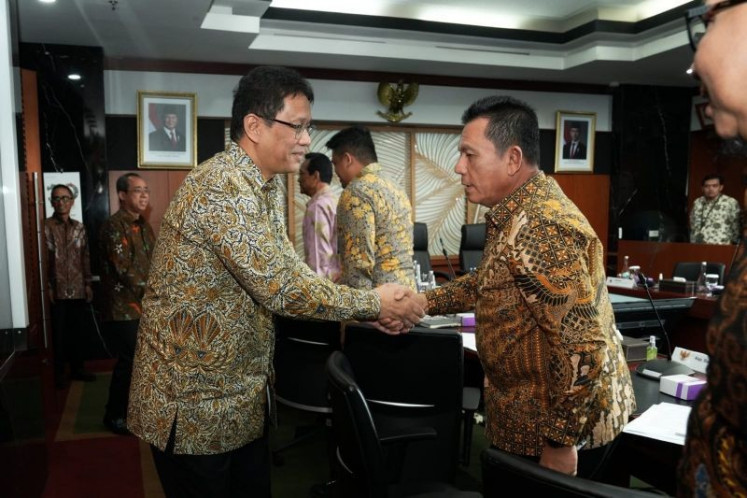Popular Reads
Top Results
Can't find what you're looking for?
View all search resultsPopular Reads
Top Results
Can't find what you're looking for?
View all search resultsGovernment urged to save Tesso Nilo National Park
The government has been asked to come up with a comprehensive policy to stop illegal encroachment on 12,000 hectares of forest per year, which is threatening Tesso Nilo National Park in Riau province
Change text size
Gift Premium Articles
to Anyone
T
he government has been asked to come up with a comprehensive policy to stop illegal encroachment on 12,000 hectares of forest per year, which is threatening Tesso Nilo National Park in Riau province.
Edward Rahadian, head of Tesso Nilo's management for region I Lubuk Kembang Bunga, said forest encroachment practices constituted the main threat for the conservation of the national park.
'Unless these are stopped, the national park will be destroyed in less than five years,' Edward told The Jakarta Post at his office recently.
Edward said that since Tesso Nilo was declared a national park in 2004, the encroached area had reached 53,530 hectares.
He blamed the high figure on the numerous access roads heading into the national park, as well as its being surrounded by industrial oil palm plantations.
Visitors to the park often come across locals clearing land in protected areas for agricultural purposes.
'Tesso Nilo has become notorious because of its damage. That's why actor Harrison Ford was so angry about it. This has to be a priority to address,' Edward said.
Hollywood actor Ford visited Indonesia last year and traveled across the country, interviewing many people along the way, including former president Susilo Bambang Yudhoyono and former forestry minister Zulkifli Hasan, as well as activists campaigning against deforestation.
Tesso Nilo is a national park with a high level of biodiversity. Each square meter of its conservation area contains 218 different plant species and 34 different animal species, including elephants and Sumatran tigers.
Meanwhile, Raflis from the Sumatra Spatial Planning Forum (Fortras) said there had been incompatibility in terms of spatial planning in Riau between the central government's vision and those among provincial and regency administrations.
He said one solution to the problem would be to provide transparent forest data, impose a forest documentation accountability test and encourage public participation in forest management.
- Unless these are stopped, the national park will be destroyed in less than five years
- Local people had cleared 38,576 hectares of the area when it was declared a national park
Riau Scale Up director Harry Oktavian said there were a number of land conflicts in the national park. According to Scale Up's data, 332 land conflicts ' primarily over the control of natural resources ' were recorded in the area between 2008 and 2013.
'Rationalization is needed to decide which parts of the national park can still be saved ecologically,' Harry said.
He added that it would be impossible to relocate locals that had cleared land in the national park, predicting that they would fight to stay there.
He went on to say that local people had cleared 38,576 hectares of the area when it was declared a national park. The same thing happened when 44,492 hectares were added to the conservation area in 2009, when locals made use of the land abandoned by concession owners when the concessions ended.
Harry said the government needed to consider local people's livelihoods if it chose to evict them from the forest. Alternatives could include encouraging the locals to help manage the national park.
One of the local residents, Iyur, 45, said she had planted vegetables and crops on 2 hectares of land in the national park last month to support her family.
She said she had no idea that the land she had cultivated was inside a conservation area. 'I bought the land for Rp 2 million,' she said.










